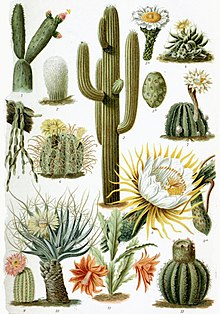Our website is made possible by displaying online advertisements to our visitors.
Please consider supporting us by disabling your ad blocker.
Cactus
| Cactus Temporal range: 35 mya to present
| |
|---|---|

| |
| Various cacti | |
| Scientific classification | |
| Kingdom: | Plantae |
| Clade: | Tracheophytes |
| Clade: | Angiosperms |
| Clade: | Eudicots |
| Order: | Caryophyllales |
| Family: | Cactaceae Juss.[1] |
| Subfamilies | |




A cactus (plural: cactuses) is a kind of a plant adapted to hot, dry climates[2] Plants which live this kind of life-style are called xerophytes. Most are succulents, which store water.
Cacti are members of the plant family Cactaceae, in the order Caryophyllales. Cactaceae were evaluated to be the 5th most endangered plant or animal family by the International Union for the Conservation of Nature.[3] There are about 127 genera, with over 1750 known species. Almost all of them are native to the Americas, from Patagonia in the south to parts of western Canada in the north. The species Rhipsalis baccifera also grows in Africa and Sri Lanka.[4]
Many cacti live in dry places, such as deserts. Most cacti have sharp thorns (stickers) and thick skin. There are many shapes and sizes of cacti. Some are short and round; others are tall and thin. Many cactus flowers are big and beautiful. Some bloom at night and are pollinated by moths and bats. Some cactus fruits are brightly coloured and good to eat: many animals eat cactus fruits.
Theophrastus was the first to use the word cactus: It comes from Ancient Greek κάκτος, kaktos. Theophrastus used it for a spiny plant whose identity is not known for sure.[5] Cacti are part of an important food chain in dry, hot climates. Now cacti have spread to many other parts of the world, and many people like to grow them in pots or gardens.
- ↑ Angiosperm Phylogeny Group (2009). "An update of the Angiosperm Phylogeny Group classification for the orders and families of flowering plants: APG III" (PDF). Botanical Journal of the Linnean Society. 161 (2): 105–121. doi:10.1111/j.1095-8339.2009.00996.x. Archived from the original on 2013-06-30. Retrieved 2013-07-06.
- ↑ The plural of cactus is cacti or cactuses or simply 'cactus'.
- ↑ Goettsch, Bárbara; Hilton-Taylor, Craig; Cruz-Piñón, Gabriela; Duffy, James P.; Frances, Anne; Hernández, Héctor M.; Inger, Richard; Pollock, Caroline; Schipper, Jan; Superina, Mariella; Taylor, Nigel P. (2015-10-05). "High proportion of cactus species threatened with extinction". Nature Plants. 1 (10): 1–7. doi:10.1038/nplants.2015.142. ISSN 2055-0278.
- ↑ Anderson, Edward F. 2001. The cactus family. Pentland, Oregon: Timber Press. ISBN 978-0-88192-498-5
- ↑ Johnson, A.T. & Smith, H.A. (1972), Plant names simplified : their pronunciation, derivation & meaning, Buckenhill, Herefordshire: Landsmans Bookshop, ISBN 978-0-900513-04-6, p. 19
Previous Page Next Page


